
Powered Brake Ducts.
Dodge Magnum Modifications
One of the realities associated with running a 4400-pound vehicle on a race track is both simple and inescapable: Making the car go fast was the easy part. Making it slow down is a whole lot more difficult.
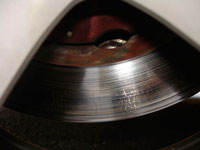 |
|
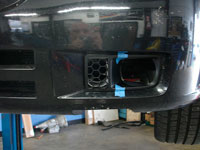 |
|
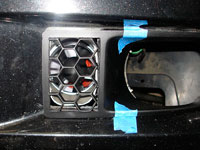 |
|
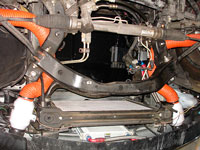 |
|
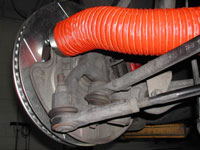 |
|
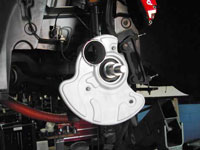 |
|
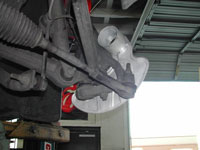 |
|
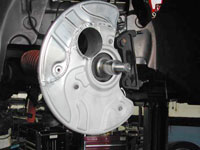 |
|
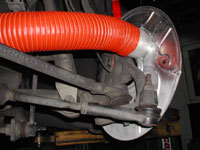 |
|
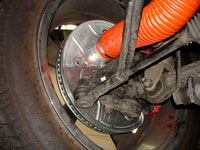 |
|
Its simple, inescapable physics. There is a good reason why high performance cars tend to also be relatively light in weight. Try and race a moving van like a sports coupe and you'll learn this very quickly.
This is not to say there are not brakes out there that are powerful enough to do the job. There are and they are installed on this car. The problem arises when you have to use those brakes over and over again; heating them to literally red-hot temperatures and keeping them there. Its tough on the hardware and unless you plan on replacing parts after literally every single track day, you have a problem you had better figure out a way to solve.
In my case, installed on the vehicle are an excellent set of Wilwood brake components. 6-piston calipers in the front, 4 in the back. The rotors were oversized as well. 14 in x 1.25 in. slotted, directionally-vaned rotors in front with similarly oversized 13 in. directionally-vaned rotors in the rear. The Wilwood brakes use stock car-type pads and a wide variety are available in compounds that are so aggressive they are unusable in street applications.
All this is great, and the car performed well in this configuration. There was just one problem: Physics. Brakes convert forward energy into heat, and a brake rotor is essentially a large iron heat sink that soaks up that energy. And a great job it did in that regard. I saw measured temperatures on the front rotors in the 1250-degree range (lets say that again... one thousand two hundred and fifty degrees). While they did the job even at that temperature, as did the pads (although I did get flagged off the course once when the rears almost caught fire), you can't heat-cycle metal like that without, well, ruining it. On Laguna Seca, which is quite tough on brakes, I would get one day's worth of use out of a set of rotors. Cryogenic treatment is supposed to work wonders to eliminate this problem. I tried it and... the rotors still cracked. Just a little bit less. I got two days out of those.
There had to be a way to cool the brake rotors, and dedicated brake ducts seemed to be an obvious answer. And not just ducts that blow air onto the rotor from the front. Spindle ducts are the correct answer. A spindle duct routes air from a source to the center point of a vaned brake rotor. Why there? Because a directionally vaned rotor is basically a very efficient impeller. Air is sucked in by the vanes from the center, run thru the interior of the rotor and exhausted out thru the edge of the rotor. Looking at a rotor edge-on you might think it is meant to 'scoop' air in from the outside where it works its way in, but the opposite is true.
So a spindle duct feeds the impeller at its intake point. You want to further design your spindle duct so it feeds air as close to the center as possible and, if it can be avoided, does NOT feed air to the inner surface of the rotor. Doing that can cause a temperature imbalance on the inside surface versus the outside, which is a bad thing. If you look at homemade brake duct projects plastered across many internet forums, you will see a lot of them botch this detail and feed air to the surface rather than the center.
After a complete examination of the front end of the vehicle, the space next to the fog light bezel is the only sensible place to put a brake duct intake (the primitive only-a-hole brake ducts employed by SRT models use this same location). You see it mocked up on the car, above (click to enlarge photo). The second, closer shot uses a flash to illuminate the inside of the tube, and the tube's contents.
That is a 3-inch, 3-amp, marine-environment bilge fan. I had the bright idea of using a fan to force-feed large quantities of air through the duct as opposed to just letting air pass through. There are a variety of 3-inch bilge fans on the market, and typically they move about 135 cfm or less. These fans, manufactured by Detmar, use a design that gives a 4-inch fan 3-inch outlets, so it moves 175 cfm. More is better.
The fans are securely mounted on rubber bushings to the radiator housing. From there they connect to silicone hose (rated for 600 degree temps... the highest available at reasonable cost) to custom-fabricated spindle ducts. Note in the picture above that the silicone hose was not secured to the frame yet, since there was no engine in the car at the time (note black hole in center of view).
The spindle ducts were made very inexpensively. They feed air straight to the center of the hub and do not blow air directly onto the rotor surface. The duct is made out of a manufacturer's spec aluminum wheel backing plate, which ordinarily only covers about 1/3 of the inner wheel. We simply bought another one for the other side of the car, cut it up and welded it to the stocker that was already in place. Poof... instant full size backing plate. Parts cost was about $10 per wheel plus a few bucks for the hose mount. A much fancier and more expensive solution could have been fabricated from scratch... with only a very small improvement in performance.
Speaking of performance, the ducts alone, without the fans running, are good for about a 200-degree temperature reduction. Switching on the fans (they are actuated via a safety switch on the dash) adds another 150 degrees of cooling on top of the gains already achieved by the unpowered duct.
By the way, when I first shared my brilliant idea with my shop, I found out once again that there are no new ideas under the sun. It turns out I am by no means the first person to think up the use of fans in brake ducts. They are common in many high-stress racing environments such as circle-track.

Matt Robertson
